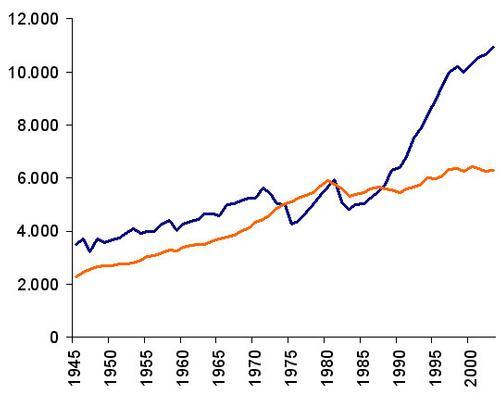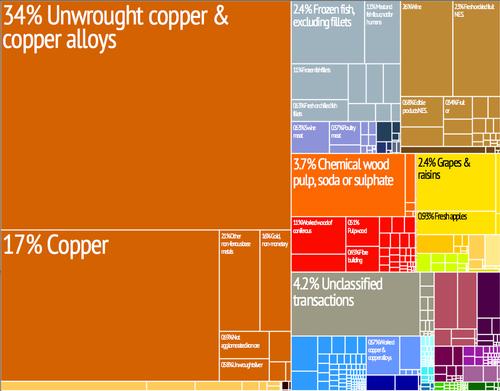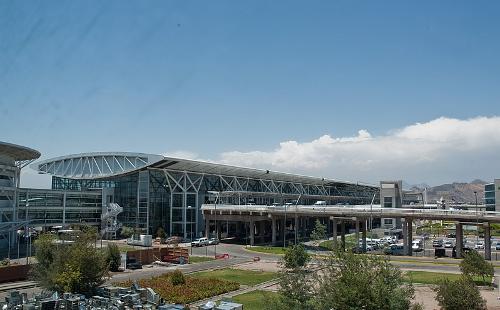CHILE
Economy

Economy

Cities in CHILE
| Santiago |
Economy
Historical overview

From 1930 to the late 1950s, a national industry was built up to replace the import industry used until then. A miscalculation was that the domestic market was too small for this and purchasing power increased too little to make this turnaround a success. In the 1960s, it was attempted by means of agricultural reforms and the search for new markets in neighboring countries. The Allende socialist government wanted to redistribute incomes and increase production capacity.
After 1973, the strong liberal policy emphasis was on exports, the elimination of trade-restricting and other protectionist measures, the freeing of prices and the creation of favorable conditions for foreign investment.
This policy led to many government layoffs and many large and small companies went bankrupt. At the end of the 1970s, the economy grew on average by 9% per year, but in 1982 another serious economic crisis broke out. After 1985, the economy recovered thanks to an increase in exports and a favorable debt settlement with the International Monetary Fund. In the period 1990-1997, economic growth reached a record value of 10%. From 1985 to 1997, inflation fell to 7%, not much compared to the 20% of the early 1980s.
From 1998, the economy was characterized by a deficit in the Chilean trade balance, for the first time in years. Gross national product also fell again for the first time since 1984. Furthermore, unemployment doubled to 12% within a year and a tax deficit arose. In the period from 2003 to 2013, Chile's economy is growing strongly by an average of 5%. In 2017, growth slowed to 1.5%
The gap between rich and poor remains invariably wide. According to official figures, in 2017, 14% of the population was living below the poverty line.
Foreign investment
Chile is making great efforts to attract foreign investment. The investment legislation and the tax system ensure that there is little in the way of foreign companies.
At the end of 2013, Chile had about 5000 foreign companies within its borders, from 60 countries. Most investments are made in the mining, transportation, telecommunications and utilities sectors. The largest investor was the United States (31%), followed by Spain, Canada, England, South Africa and the Netherlands (2.8%).
The investments were mainly made in financial services, industry, mining, fish farming, horticulture and transport.
Labour market.
The official unemployment rate was 7% in 2017. Incomplete employment, hidden unemployment and seasonal unemployment are excluded from the official statistics, as is the large number of so-called 'inactive' people looking for work.
Combating unemployment is seen primarily as a task for private industry. The government only supports a few special job creation programs. 9.2% of the labor force works in agriculture, 23.7% in industry and 67.1% in services (2017).
Agriculture, forestry and fishing

Approx. 42% of the total Chilean soil area is cultivated: 6% is arable land, 16% pasture land and 20% forest. Within the total agro-sector, the breakdown by sectors for the share in the gross domestic product is as follows: fruit cultivation 30%, livestock farming 27%, arable farming 17%, horticulture 13% and forestry 13%. Employment in the agricultural sector accounts for 780,000 employees, approximately 14% of the labor force.
Most agricultural products are grown in the central valley and the regions of Bío-Bío and La Araucana. The main products are cereals, potatoes, sugar beets, corn and fruit. The share of agriculture in the gross national product (15% in 1950) has fallen to 4.4%, while 9.2% of the labor force is employed in this sector. (2017) The export of agricultural products is strongly stimulated, and Chile is currently the largest fruit exporter in the world. Important products are table grapes, pears, apples, melons. The main export destinations are the United States, Mexico and the Netherlands.
Extensive livestock farming is possible due to the extensive natural pasture areas. In the southern region between Bío-Bío and Llanquihue, 50% of the cattle farming is concentrated. The importance of pig fattening and sheep farming for wool exports is increasing. The country can largely feed itself and is therefore hardly dependent on food imports. Since 2000, there has been a modest rise in meat exports.
Chile has extensive forest areas, but due to the lack of transport options, this sector is not yet much of an economic value. The main tree species are conifers, especially the pine "pino radiata", and the eucalyptus. The pino radiata only needs eighteen to twenty years to reach full maturity and already covers 82% of the total planted area. Its exploitation is mainly concentrated in the provinces of Cautín and Valdivia.
Major export products are plank wood, hardboard, veneer, wood chips and pulp, especially for the Japanese market. 70% of the forest area is privately owned. The forests in the south are threatened by overexploitation.
Chile benefits from the great wealth of fish and shellfish in its coastal waters and therefore has a thriving fishing and fish processing industry. The main fishing zone is in the north, the southern waters are important for crustaceans and molluscs. The total annual production is 6 to 7 million tons. This makes Chile the most important fishing country in South America and the largest fishmeal exporter in the world. Catches are further processed into fish oil and packaged products for human consumption.
The ceiling in the fishery has almost been reached due to overfishing. The focus is now more on mussel and salmon aquaculture. Chile, along with Norway, occupies the first place in the world ranking for the production of farmed salmon. The Dutch Nutreco is the market leader in Chile. After the production of salmon and trout has increased enormously, the focus in the coming years is on the cultivation of fish species such as turbot, shark and catfish.
Mining

Chile has large reserves of mineral raw materials. Copper mining is still by far the most important source of income, and still accounts for 34% of export revenues (1972 still about 75%!). The total stock is estimated at 700 million tons, which is 40% of the world stock. Chile is currently the largest producer of copper ore in the world. Since 1971, the five largest mines have been managed by the government company CODELCO, previously these mines were in American hands.
Major by-products of copper mining are gold, silver, zinc, lithium (the lithium reserves in Salar de Atacama are considered the largest in the world), nitrate, boron, cobalt, manganese and especially molybdenum, the exports of which are increasing spectacularly. Uranium and iron ore are also becoming increasingly important as export products. Saltpetre, Chile's most important source of income in earlier years, now plays only a modest role.
Oil and natural gas are extracted by the public company ENAP, but the aim is increasingly to cooperate with foreign companies. Own production is falling and people are forced to import more and more petroleum. Oil production currently does not yet meet 10% of Chile's oil needs. Rising world market prices mean that increasing oil imports are putting an ever greater burden on the trade balance.
Industry
CHEMISTRY AND PLASTICS
Some companies operate on the world market. Examples are Methanex Chile (methanol), Group SQM (nitrates, iodine, iodides), and Sociedad Chilena de Litio (lithium carbonate). The natural gas derivative methanol is produced on a world scale in the far south of Chile, at Cabo Negro near Punta Arenas. The production of 3 million tons of methanol makes Cabo Negro the largest methanol complex in the world.
FOOD AND ENDORSEMENTS
Due to the increased domestic demand and the successful export of products from agriculture, horticulture and the agro-industry, the Chilean production sector for food, beverages and tobacco is becoming increasingly interesting economically. The consumption of basic basic foods such as potatoes and wheat fell sharply, that of dairy and meat products increased sharply.
Trade
 Chile ExportPhoto: R Haussmann, Cesar Hidalgo, et. al. CC 3.0 no changes made
Chile ExportPhoto: R Haussmann, Cesar Hidalgo, et. al. CC 3.0 no changes made
Chile has a very active policy in entering into bilateral and multilateral trade agreements, mainly with countries in Central and South America. In November 2002, the European Union and Chile concluded an association agreement including a free trade agreement, the goods part of which entered into force on February 1, 2003.
The association with Mercosur (common market in South America, consisting of Brazil, Argentina, Paraguay and Uruguay) in 1996 was of great importance, as it is the main outlet for Chilean products. Chile is committed to full membership of Mercosur.
The Chilean economy relies heavily on international trade. The number of different export products also increased very rapidly from 1,500 in 1989 to 3,800 in 2000. Traditional export products are gold, nitrates, fishmeal and especially copper. Important new export products are cellulose, fruit, salmon and especially wine.
Goods imports rose from $ 7.1 billion in 1990 to $ 60 billion in 2017, partly due to the high oil price.
ICT
The Chilean ICT sector focuses mainly on telecommunications. Due to a competitive battle, the rates for mobile telephony fell drastically. The result was a large increase in the number of mobile phones.
Traffic
 Comodoro Arturo Merino Benítez International AirportPhoto: Phillip Capper CC 2.0 Generic no changes made
Comodoro Arturo Merino Benítez International AirportPhoto: Phillip Capper CC 2.0 Generic no changes made
The road network is fairly well developed between the regions of La Serena and Puerto Montt, as well as between Valparaíso and Santiago and other important cities. The inland road network covered approximately 80,000 km in 2001. The main north-south connection is the Carretera Panamericana (Pan American Highway), which enters Arica from Peru and then extends beyond Puerto Montt, with even an extension on the island of Chiloé.
There are three motorways with Argentina: from Valparaíso to Mendoza (Carretera Transandina), in the north from Antofagasta to Salta and in the south from Osorno to Bariloche. A motorway runs from Arica to the Bolivian capital La Paz. A lot of money has been pumped into this infrastructure in recent years.
The railways are almost entirely owned by the state, but partial privatization and modernization of the railways are foreseen. The Iquique-Puerto Montt line, with several east-west branches, has three different track gauges. In 1975 the urban metro was opened in Santiago.
Chile has a large number of airports and airfields, 10 of which are used for international traffic. The largest airport is that of Santiago.
The main airline is Linea Aérea Nacional (LAN), which serves all major Chilean cities and has connections from Pudahuel International Airport near Santiago to the main Latin American cities, the United States and Western Europe.
Chile has a total of 47 seaports, 12 of which are suitable for international shipping and cargo handling. Valparaíso in central Chile is the largest of the seaports. Other major seaports are those of San Vicente in the south and Antofagasta in the north.
Private capital investment has been permitted since 1979 on the Santiago railways, shipping, airlines, ports and metro.
In 1999, the privatization of the country's three main ports brought hard clashes with dockers, but President Frei reached an agreement with the port unions. The privatization of the ten main Chilean ports will continue in the coming years.
Approx. 95% of Chile's foreign trade goes through its seaports.
Sources
Asal, S. / Chili
Lannoo.
Caistor, N. / Chili : mensen, politiek, economie, cultuur
Koninklijk Instituut voor de Tropen / Novib.
Castillo-Feliú, G.I. / Culture and customs of Chile
Greenwood Press.
Dwyer, C. / Chile
Chelsea House Publishers.
Filippo, H. / Chili
Elmar.
CIA - World Factbook.
BBC - Country Profiles.
Copyright: Team The World of Info